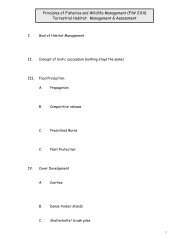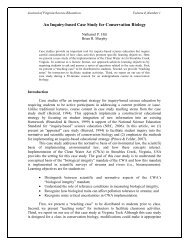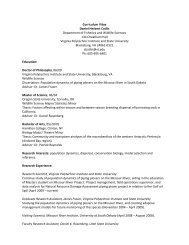Kernel Home Range Estimation for ArcGIS, using VBA - Fish and ...
Kernel Home Range Estimation for ArcGIS, using VBA - Fish and ...
Kernel Home Range Estimation for ArcGIS, using VBA - Fish and ...
Create successful ePaper yourself
Turn your PDF publications into a flip-book with our unique Google optimized e-Paper software.
Silverman (1986) first described kernel density estimation <strong>for</strong> the layperson. As a result, much of<br />
the subsequent kernel home range literature rests heavily on this work. Silverman describes<br />
kernel estimation as follows (Figure 4.1.1. adapted from Silverman, 1986). Density estimation in<br />
its simplest <strong>for</strong>m is a histogram representation of the variable in question (i.e. the x or y<br />
coordinate of a set of locations) (Figure 4.1.1.a.). The naïve estimator is a histogram constructed<br />
such that each point falls in the centre of a sampling interval (bin) (Figure 4.1.1.b.). In this<br />
method, the sampling intervals overlap, <strong>and</strong> the points that are included in any interval are<br />
weighted according to a uni<strong>for</strong>m distribution. The kernel estimator is an improvement of this<br />
naïve estimator in that it replaces the uni<strong>for</strong>m weighting function with a kernel function. This<br />
kernel function is a probability density function with a specified distribution (Figure 4.1.1.c.).<br />
Equation 1 defines the kernel density estimator:<br />
a b c<br />
Figure 4.1.1. Progression of density estimation from simple histogram techniques to smooth<br />
kernel estimation (Adapted from Silverman, 1986). In these examples, the abcissa (x axis)<br />
could be x coordinate <strong>for</strong> a set of locations, that in the animal spends more time or is seen<br />
more in the center of the distribution in the x direction.<br />
( x − X )<br />
n<br />
⎡ ⎤ ⎧ i<br />
f ˆ 1<br />
( x)<br />
= ⎢ ⎥<br />
( ) ∑ K ⎨<br />
⎣ nh ⎦ = ⎩ ⎭ ⎬⎫<br />
2<br />
i 1 h<br />
(1)<br />
K is the kernel that determines the shape of the distribution that is placed over each of the points.<br />
h is the smoothing factor (also known as the smoothing parameter, b<strong>and</strong>width <strong>and</strong> window width),<br />
which controls the search radius or width or the kernel. n is the number of location estimates<br />
(points) used in the analysis. x <strong>and</strong> X refer to the vectors of the coordinates of the evaluation<br />
point <strong>and</strong> all other points, respectively. Various kernels have been described (Silverman, 1986),<br />
but kernel analysis has been shown to be relatively insensitive to the choice of kernel (Silverman,<br />
1986). Seaman <strong>and</strong> Powell (1996) use, as an example, the Biweight <strong>Kernel</strong>, K B2B from Silverman<br />
(1986). Equation 2 defines the biweight kernel:<br />
10









